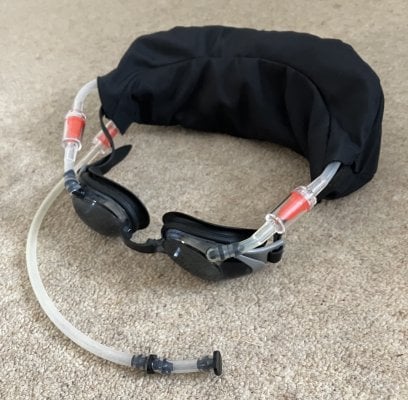Indeed, I recall seeing the Evolve FREEQs were 'coming soon' when I was searching to see if anyone was making self-eq goggles (that was probably around the same time I started this thread).
The website says they can be used down to 70m, though it also suggests sensible recreational depth seems more like 40-50m. It mentions "for clear vision", and I'm wondering if that means the air-space around eyes starts to get rather small after that, with the water-holding bags pushing in far enough to obscure the field-of-view...? Still, 40m should be plenty of depth for the majority who are just out to enjoy some freediving rather than competing, and perhaps some spearos would also be happy to use them due to the benefit of hands-free eq.
They are a bit pricey, I think (- but I guess it must be expensive to design and manufacture fairly 'niche' products like this).
One of the things I discovered when I first made my own mod is that swimming goggles do need to have a little bit of pressure difference between inside of the eyepieces and outside - this helps keep them slightly 'sucked' onto the face to prevent leaks. I achieve this in mine using one-way valves that cause some resistance to the movement of air from the external airbags, so air only starts to move into the eyepieces once the pressure difference increases a bit beyond that.
I'm wondering how that works with the FREEQs...? I see there are holes that allow water to move into the internal expanding water 'bags', but doesn't that mean air can get in there when not under the water, which I'd think would prevent such a 'suction' effect until underwater, and might mean they could leak a bit at the start? Presumably, these holes are small enough that, once underwater, the more viscous water only seeps through the holes relatively slowly, which then retains a bit of a pressure difference to keep the slight suction and avoid any water leaking in?
I've only had chance so far to go down about 30m with my own modded goggles, but I'm pretty sure they'd go at least twice that deep, given how much was still left in the airbags afterwards. It's certainly really nice to be able to eq hands-free, as well as not bothering about mask eq at all. TBH, I find them better than any mask I've tried!

It looks like the FREEQs are sold out, so I guess there must be someone out there somewhere who has tried these - would certainly be interested to hear any feedback...
 , maybe improved MDR from water on face.
, maybe improved MDR from water on face. let me know!)
let me know!)


